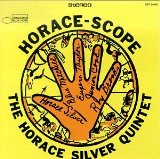From Wikipedia…
Nica’s Dream is a jazz composition by Horace Silver from the year 1954.
Nica’s Dream has 64 bars in the AABA form, in a moderately fast pace. It is one of the most famous compositions Silvers and a classic of hard bop. Silver understood the book as a reference to his friend and patron of the former jazz scene, Nica de Koenigswarter named Nica.
Besides the numerous recordings of Horace Silver’s Nica’s Dream by Art Blakey, Curtis Counce, Blue Mitchell, Joe Pass, Mel Torme, and Phil Woods has been included.
This is good repertoire to learn and use for jam session. We mostly use intro and outtro from original version. Optional easy jamming is just put ‘VAMP’ for intro, outtro, or beginning of solo.
Original Version
国立音楽大学 NEWTIDE JAZZ ORCHESTRA – NIca’s Dream
J-POP version:
More about this original version
from http://www.newworldrecords.org/liner_notes/80242.pdf
Nica’s Dream(Horace Silver)
The Jazz Messengers: Donald Byrd, trumpet; Hank Mobley, tenor saxophone; Horace Silver, piano; Doug Watkins, bass; Art Blakey, drums.
“Nica’s Dream” is one of the many compositions dedicated to Baroness Pannonica (“Nica”) de Koenigswarter, a great friend of jazz musicians since the early fifties, when she first came to New York. Thelonious Monk’s “Pannonica” and Gigi Gryce’s “Nica’s Tempo” are other well-known tributes to the jazz baroness, as she has been called. Silver recorded this piece again in 1960 for Blue Note, and it has also been done by several other groups.
The band heard here was the second edition of the Jazz Messengers, with Donald Byrd replacing Kenny Dorham.Shortly after this recording Blakey and Silver formed separate groups.
“Nica’s Dream” is one of Silver’s most memorable compositions and is typical of his best work at the time. Its rich harmonies and rhythmic shadings, the latter especially noticeable in the bridge, give the soloist much substance on which to develop his improvisation.
Hank Mobley, who solos first, displays a burry warmth in his tone, a sound somewhere between the cool lightness of Stan Getz and the harder edge of Sonny Rollins or John Coltrane. Here Mobley’s ideas flow readily, spurred on by the superb rhythm section. Never a particularly fashionable tenor player, Mobley has been more influential than he is usually give credit for. Saxophonists like George Coleman, Tina Brooks, Clifford Jordan, and Junior Cook all absorbed something from his sound and his rhythmic ideas.
At this time and for the next few years Donald Byrd was probably the most in-demand trumpet sideman in jazz and appeared on countless record dates. An inconsistent soloist he is in good form here, playing a graceful melodic solo that draws on both Miles Davis and Clifford Brown.
Silver is one of the great piano accompanists-his percussive, perfectly placed chording is always a stimulus to the soloist. His won solo begins with a characteristic trill and continues in his typically blues-oriented, direct and uncluttered style. Due to the nature of the material, Blakey is somewhat subdued. But his bright cymbal work is a delight, and he maintains the Latinish rhythmic feel with just the right touches without.
Blakey and Silver’s later work in the fifties had a more pronouncedly funky sound that is evident in “Nica Dream”(see Discography).Silver and Blakey may be heard playing Silver’s “Stop Time” on NW 271, Bebop.

ทักทาย